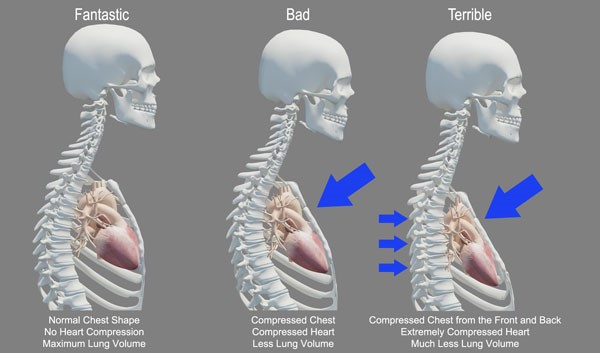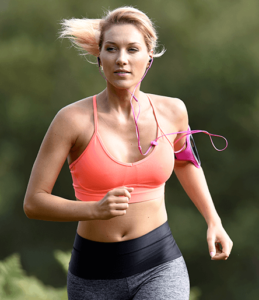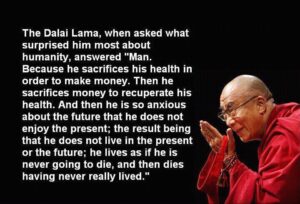Why Stretch or Warm Up? What is its Usefulness?
Watch this video to find out.
Find out more @
it’s not just working out. It's building a foundation for a better life.
Being in this field it is impossible to not get attached to the people you work with. Some of my greatest joys are to get to know each person personally and to hear the amazing stories that come from their mouths. It is an amazing treat. And when you are able to help them it is an extra special bonus knowing where they have come from and what they had to go through to get there. Janette extremely epitomizes this process. I have a real place in my heart for who she is and what she had to go through to get where she is now. Even though it completely makes sense to me that she could do it through the SolCore Fitness program, her journey is truly inspiring to me.
Janette is approximately my age, 40-ish, but she came to us with the body and spine of a 90 year-old. She was in constant semi-debilitating pain. The only thing that kept her going was a sense of duty to her family and hope that she could get out of this situation.
This situation was one to where she had gone from a thriving young woman with a husband and two kids to a woman that was just trying to get through her day. Her sole goal each day was to not get in any more pain and make it back home, to where she promptly collapsed not able to interact with her family. She sought help form chiros, massage therapists and PT’s but the pain in her back and neck was getting worse. It got so bad she was not even able to give her daughters a bath because she couldn’t reach over the tub.
To make matters worse she couldn’t use pain meds, and she knew that all the doctors wanted to do was to fuse her spine. Luckily, she found a DOM that was able to subside her pain somewhat and she reached out to us to “put her back together.” When I talked to her before starting, I told her that what she had wasn’t that difficult to fix, it just wouldn’t feel that great doing it and would take awhile.
Being the focused person that she is, she committed herself to try it for six months. My main direction to her was to go slow.
Let me tell you how committed Janette is. On her initial session when she did the wall stretch she was brought to tears because of the tissue being pulled back into place.
You see when tissue heals after an injury without it being put back into place properly it heals “out of order.” So when you start correcting, it doesn’t feel so nice.
This pain happened to her whenever she did a class or while she did her stretching homework at home, but she persisted. At one point her husband asked her why she kept going back and she said, “Because this has to work.”
I can’t tell you how many times I walked over to her during a class and saw her struggling just to stay in the posture on the verge. But I am glad that she kept with it because she now has pretty much no pain, has gotten back into lifting and running but more importantly she is a participant in her family’s life again.
It is my absolute pleasure to introduce Janette as the December Member of the Month.
1) What made you decide you wanted/needed to start a program?
I was sick and tired of being in so much pain and I had to try one more time to get rid of it. I knew that there had to be a way out of it. Your program spoke to me and I dove in.
2) What did you do before?
I used to workout a ton. Lifting weights, running and just being active. I go to an acupuncturist and I was seeing a PT before this but was given up on and told there was nothing that could be done.
3) What results have you achieved since starting your program that you are proud of?
My pain has gone from unbearable to almost gone and I am now able to be present in my family’s life. I can play with my kids. I can workout again. I feel like myself again.
4) Do you have a favorite exercise? Least? What do you like or don’t like about them?
I love lifting weights! It feels so good to be able to move like that again. The lower to mid thoracic ELDOA’s are murder for me. I know that they are exactly what I need, but they are tough.
5) What are some challenges or goals you are currently working on?
I would like to continue to be able to keep correcting my posture and to lose the 10-20 lbs I put on when I couldn’t move.
6) What do you like best about our program/ having a trainer?
That it works! I love the personal attention. The way the program is put together and is taught just makes sense.
7) What advice would you give to the other SolCore Fitness members?
Keep going! You have got to take it one class at a time and do what you can. When you don’t feel like going…go anyway! Do your homework. Even a little bit is going to dramatically help you.
8) What would you say to someone on the fence about joining our program?
Do it! But if you do give yourself some time to work it. You should be in it for a minimum of three months to even start to feel where it is going. If this program can work for me it can work for anybody.
Find out more @
If you answered “yes” to any of those (and most people will answer yes to at least one), you may have poor thoracic spine mobility. Even if you don’t notice any of the symptoms leaping out at you, it never hurts to get more mobility, especially in the thoracic spine. And establishing good habits by actively maintaining and training mobility, as opposed to being content with what you have (even if it’s not optimum), is always a good move.

After the hips, thoracic spine mobility is probably the most crucial aspect of mobility. At least with the hips, though, people can identify them and grasp the concept of hip mobility just by reading text on the computer. Sticking your hips back is pretty self-explanatory. What about the thoracic spine? It’s a bit more nebulous.
Do you know how to use your thoracic spine? Are you even aware that it exists? It’s not that people ignore the thoracic spine willfully; it’s that they’re unaware of any distinctions between spinal and lumbar vertebrae. They know about the spine, and imagine it to be a uniform vertebral column, equally capable of bending, twisting, and rotating along its length. This is totally understandable. “Spine” is what we hear, not “thoracic spine” or “lumbar spine” or “cervical spine,” but it’s much more than that.
The human spinal column is composed of five segments: the cervical spine, which extends up the neck to the base of the skull; the thoracic spine, which encompasses the shoulder and chest area; the lumbar spine, also known as the lower back; the sacrum; and, finally, the coccyx, or tail bone. Each performs a different role. Each has different capabilities, different functions. Most importantly, each segment of the spine is designed for a certain range of motion.
The thoracic spine is built for rotation, flexion, and extension. It is highly mobile – or, rather, it has the potential for lots of mobility. Because of its mobility, the thoracic spine must be used, must be moved. But it has to be known. If people are unable to visualize and feel the movement of the thoracic spine, or if they’re unable to even grasp the concept of its existence, they’ll just attempt to twist, rotate, flex, and bend with something familiar to them: the lumbar spine. That’s bad news.
The lumbar spine is built for stability. It’s supposed to support the weight of the body (plus any added weights) and resist excessive rotation and twisting. It remains stable and acts as a conduit for power generated by the hips and fed to the mobile thoracic spine. It is not meant to twist and bend. It can move, obviously, but it’s not meant to be wildly mobile. It’s meant to be solid, reliable.
You’ll find that an immobile thoracic spine isn’t just bad for the vertebrae themselves. It’s bad for your lower back and your shoulders, too. In fact, you’ll rarely feel actual pain along the twelve vertebrae that comprise your thoracic spine. Instead, your lower back will take over work for which it’s really not designed, getting chronic pain for its troubles, and your scapula (shoulder blades) will compensate by moving away from the spine, making overhead shoulder work difficult, dangerous, and painful, and a rotator cuff injury nearly inevitable. Everything in the body is linked, remember, and you can’t remove a major player from the equation without seriously affecting the balance.
Benefits of improved thoracic mobility are: Lack of kyphosis, a less painful, more stable lower back, more lung volume, Healthier shoulders, Greater range of motion …
Do use thoracic mobility to:
a. Lengthen and straighten your thoracic spine with ELDOA’s
b. Breathe more deeply
c. Enable your shoulders to roll further back without swaying the low back
Don’t use thoracic mobility to:
a. Hunch your thoracic spine
b. Hyper-extend your thoracic ligaments creating laxity in the ligaments and hyper-mobility in the thoracic spine.
So, it is important to develop thoracic mobility in a precise way that allows healthy spinal architecture and movement and not in a way that threatens your skeletal integrity or scaffolding. Loosening up the thoracic spine and then using that extra mobility to round or distort the spine further while sitting or standing is in some ways worse than being inflexible. It is therefore crucial to be conscious of posture as well, so that your whole spine is well-aligned throughout your day, and any extra mobility you create in your thoracic spine works to your advantage and towards making you straighter and taller.
Find out more @
Recently, at SolCore Fitness, I have had some conversations discussing the intake of water and I wanted to elaborate. Because we live in a dry, high desert environment, and the temperature has been rising in Santa Fe, staying hydrated is obviously very important. I also believe it is essential during exercise.
Water affects every organ and cell within your body. You may not have known this, but water even plays an enormous role in the health of your back and spine. The lack of proper hydration could affect your back and could be a cause of back pain. Between every two vertebrae lies a disc, which functions as a shock absorber. This disc has two parts: an outer, flexible and tough ring, and the inner, which is primarily water. All day long, as gravity works on our upright spine, water is slowly squeezed out of the discs.
 At night, when we are lying down, the discs slowly rehydrate. Our daily dehydration and nightly rehydration of the discs is the reason why most of us shorter at night than when we woke up! Regular movement helps to keep discs hydrated – as the spine moves, the discs will absorb the water we have available in our bodies.
At night, when we are lying down, the discs slowly rehydrate. Our daily dehydration and nightly rehydration of the discs is the reason why most of us shorter at night than when we woke up! Regular movement helps to keep discs hydrated – as the spine moves, the discs will absorb the water we have available in our bodies.
As long as there are adequate water levels within the body, nightly rehydration will occur. When there is not enough water available to fully hydrate the inner part of the disc, the whole piece becomes compromised. When the inner piece of the disc are dehydrated, it cannot support the load on your spine as intended, and it stresses your body causing pain. This means that drinking lots of clean water helps you to have less pain and easier movement. Don’t wait until you are thirsty to drink, that means you are already dehydrated.
Because discs do not have a blood supply, they exchange nutrients when pressure is decreased. This is why when you lie down or sleep at night, the discs will rehydrate. This process nutrient exchange can be increased even further and have more lasting results when ELDOA exercises are performed. One of the benefits of the ELDOAs is that they assist to reinforce the tissue responsible for supporting the spine in a more elongated state. The result is that the spine becomes more resilient to the compressive forces placed upon it throughout the day, as there is less water loss from the discs. However, there needs to be enough free water available in the body for the ELDOAs to be affective.
So, be honest with yourself, are you drinking enough water? Take responsibility for the health and longevity of your spine by doing these 3 simple things:
1. Drink water first thing in the morning before your coffee or tea and breakfast
2. Carry a water bottle that you really like – this will help keep you drinking throughout the day to reach your daily target of fluid ounces
3. Do 2 or 3 ELDOA exercises each night before bed
Happy Hydrating!!
Get more information @
Being in the health and fitness field and helping people get rid of back, neck and hip pain, I get a lot of articles sent my way for examination. And I love it! So keep them coming. I love reading about what is going on in all corners on the health and fitness field(s). I really appreciate that people are trying to learn more and are looking for solutions outside of surgery and consistent pain medications. This article is influenced by an article published in the Wall Street Journal about back pain. You can see the WSJ article here: ( http://www.wsj.com/articles/new-help-for-back-pain-1448311243 ).
SolCore Fitness Personal Training Santa Fe was birthed out of the necessity. I had back pain from a pinched L4-L5 vertebrae and intermittent Sciatic pain. I tried medications (knowing full well it wouldn’t cure me), chiropractic (helped for a week or so), yoga (didn’t work and made it worse) and some physical therapy exercises that also didn’t work and made it worse. And even though I had all these failures I knew that there had to be some way to “put myself back together.”
Because of the belief that I could put myself together, I found a program called Soma Training/Therapy, which contains ELDOA. This program completely blew what I knew out of the water and got rid of my back pain. Prior to finding this system, I did what most people did and used general formulaic answers to problems that arose for myself and my clients. But after getting hurt and seeing that this formulaic way of thinking wasn’t working, I was forced to find what would work consistently.
Which brings me to the article. The first thing that caught my eye was the fact that people are realizing consistent surgery and medications are not the way. It has been said that only 1% of the people who go in for back surgery even need it. This article ( http://www.nbcnews.com/id/39658423/ns/health-pain_center/t/back-surgery-may-backfire-patients-pain/#.Vxu1iZMrLeQ ) talks about how surgery is being used as a cure-all and as a bi-product for pain medication (particularly opioids). But it’s not working. And as the article just prior states, it is really hard to see the cause of back pain from an MRI. Further, if you are looking at a person 30 years old or older, you are going to see some sort of damage to the spine. The problem is that the observed damage is generally asymptomatic and/or is not the root cause of the pathology.
The idea should be to look at the body holistically, to see how multiple different factors are playing into the issue. Once you do this, you can start to think about using specific stretches and exercises to normalize (correct) the different areas that are causing the imbalanced body. And when you talk of specifics you must take into the consideration the biomechanics of the body.
The initial WSJ article that was sent to me, lists four exercises that should help your back pain. However, as I stated before there could be numerous reasons that you have back pain. The exercise recommendations used in the article seem to assume that the issue is coming only from the spine. In an effort to analyze the exercises and for ease, let’s just go ahead and assume that indeed the problem is originating in the spine. Now let’s examine the exercises.
If you want to mobilize and give your spine some space, then the best things to do are to be able to translate it side to side and to do ELDOA’s. You can see an info video here and a montage of ELDOA’s and Myofascial stretching…. HERE. (This video is for example purposes only and was not designed to be followed).
Again your back pain could come from a lot of different sources and needs to be addressed as such. Don’t settle for a formulaic system to solve it.
If you are truly looking for a cure to back pain, find a practitioner near you who is educated in Soma training/therapy and knows ELDOA. I have been back pain free for 8 years and I’m not held back in the least. ELDOA along with a complete health and fitness program has also helped hundreds of our members get rid of pain and achieve a level of fitness greater than they ever thought.
If you are in Santa Fe and would like to attend a free ELDOA class this Saturday April 30th at 11 am please register HERE.
Get more information @

This is an interesting article that I notice often in my studio during … [Read More] about How to Make The Time Go Faster During A Workout

You've heard it before, "Your house is the most valuable thing you have." While … [Read More] about You are the most valuable thing you have

The big smile that Katy comes in with is always a joy to see. But situations with her body were … [Read More] about Katy G – When All Else Failed, She Tried Again And Succeeded